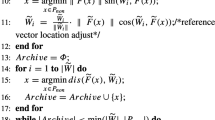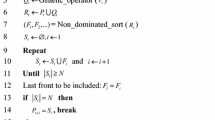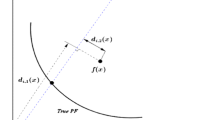Abstract
Multi-objective evolutionary algorithms (MOEAs) have proven their effectiveness in solving two or three objective problems. However, recent research shows that Pareto-based MOEAs encounter selection difficulties facing many similar non-dominated solutions in dealing with many-objective problems. In order to reduce the selection pressure and improve the diversity, we propose achievement scalarizing function sorting strategy to make strength Pareto evolutionary algorithm suitable for many-objective optimization. In the proposed algorithm, we adopt density estimation strategy to redefine a new fitness value of a solution, which can select solution with good convergence and distribution. In addition, a clustering method is used to classify the non-dominated solutions, and then, an achievement scalarizing function ranking method is designed to layer different frontiers and eliminate redundant solutions in the environment selection stage, thus ensuring the convergence and diversity of non-dominant solutions. The performance of the proposed algorithm is validated and compared with some state-of-the-art algorithms on a number of test problems with 3, 5, 8, 10 objectives. Experimental studies demonstrate that the proposed algorithm shows very competitive performance.












Similar content being viewed by others
References
Farina, M., and Amato, P.: (2002). On the optimal solution definition for many-criteria optimization problems. Fuzzy Information Processing Society, Nafips Meeting of the North American. IEEE. 233-238
Li B, Li J, Tang K, Yao X (2015) Many-objective evolutionary algorithms. Acm. Comput Surv 48(1):1–35
Ishibuchi H, Tsukamoto N, Nojima Y (2008), Evolutionary many-objective optimization: A short review. 2008 IEEE Congress on Evolutionary Computation. IEEE, pp 2419–2426
Ikeda K, Kita H, Kobayashi S (2001) Failure of Pareto-based MOEAs: Does non-dominated really mean near to optimal?. In: Proceedings of the 2001 Congress on Evolutionary Computation. IEEE 2:957–962
Khare V, Yao X, Deb K (2003) Performance scaling of multi-objective evolutionary algorithms. International conference on evolutionary multi-criterion optimization. Springer, Berlin, Heidelberg, pp 376–390
Adra S, Fleming P (2010) Diversity management in evolutionary many-objective optimization. IEEE Trans Evolut Comput 15(2):183–195
Deb K, Pratap A, Agarwal S et al (2002) A fast and elitist multiobjective genetic algorithm: NSGA-II. IEEE Trans Evolut Comput 6(2):182–197
Zitzler E, Laumanns M, and Thiele L (2001), SPEA2: Improving the strength Pareto evolutionary algorithm for multiobjective optimization. TIK-report, p 103
Zhou A, Qu B, Li H et al (2011) Multiobjective evolutionary algorithms: a survey of the state of the art. Swarm Evolut Comput 1(1):32–49
Laumanns M, Thiele L, Deb K, Zitzler E (2002) Combining convergence and diversity in evolutionary multiobjective optimization. Evolut Comput 10(3):263–282
Deb K, Mohan M, Mishra S (2005) Evaluating the \(\varepsilon\)-domination based multi-objective evolutionary algorithm for a quick computation of Pareto-optimal solutions. Evolut Comput 13(4):501–525
Farina M, Amato P (2004) A fuzzy definition of ’optimality’ for many criteria optimization problems. IEEE Trans Syst Man Cybern-Part A: Syst Humans 34(3):315–326
Kppen M, Vicente-Garcia R, and Nickolay B (2005), Fuzzy-Paretodominance and its application in evolutionary multi-objective optimization. In: International Conference on Evolutionary Multi-Criterion Optimization. Springer, Berlin, Heidelberg, pp 399-412
Yang S, Li M, Liu X et al (2013) Zheng, A grid-based evolutionary algorithm for many-objective optimization. IEEE Trans Evolut Comput 17(5):721–736
Coello C A C, Oyama A, and Fujii K (2013), An alternative preference relation to deal with many-objective optimization problems. In: International Conference on Evolutionary Multi-Criterion Optimization. Springer, Berlin, Heidelberg, pp 291-306
Li M, Yang S, Liu X (2013) Shift-based density estimation for Pareto-based algorithms in many-objective optimization. IEEE Trans Evolut Comput 18(3):348–365
Zhang X, Tian Y, Jin Y (2014) A knee point-driven evolutionary algorithm for many-objective optimization. IEEE Trans Evolut Comput 19(6):761–776
Zitzler E (2004), Indicator-based selection in multiobjective search. In: International conference on parallel problem solving from nature. Springer, Berlin, Heidelberg, pp 832-842
Beume N, Naujoks B, Emmerich M (2007) SMS-EMOA: multiobjective selection based on dominated hypervolume. Euro J Oper Res 181(3):1653–1669
Bader J, Zitzler E (2011) HypE: an algorithm for fast hypervolume-based many-objective optimization. Evolut Comput 19(1):45–76
Coello C C A (2015). Improved metaheuristic based on the R2 indicator for many-objective optimization. In: Proceedings of the 2015 Annual Conference on Genetic and Evolutionary Computation, pp 679-686
Zhang Q, Li H (2007) MOEA/D: a multiobjective evolutionary algorithm based on decomposition. IEEE Trans Evolut Comput 11(6):712–731
Li H, Zhang Q (2008) Multiobjective optimization problems with complicated Pareto sets, MOEA/D and NSGA-II. IEEE Trans Evolut Comput 13(2):284–302
Liu H, Gu F, Zhang Q (2014) Decomposition of a multiobjective optimization problem into a number of simple multiobjective subproblems. IEEE Trans Evolut Comput 18(3):450–455
Li K, Deb K, Zhang Q, Kwong S (2015) An evolutionary many-objective optimization algorithm based on dominance and decomposition. IEEE Trans Evolut Comput 19(5):694–716
Li M, Yang S, Liu X (2015) Pareto or non-Pareto: Bi-criterion evolution in multiobjective optimization. IEEE Trans Evolut Comput 20(5):645–665
Cheng R, Jin Y, Olhofer M (2016) A reference vector guided evolutionary algorithm for many-objective optimization. IEEE Trans Evolut Comput 20(5):773–791
Liu Y, Gong D, Sun X, Zhang Y (2017) Many-objective evolutionary optimization based on reference points. Appl Soft Comput 50:344–355
Deb K, Jain H (2013) An evolutionary many-objective optimization algorithm using reference-point-based nondominated sorting approach, part I: solving problems with box constraints. IEEE Trans Evolut Comput 18(4):577–601
Elarbi M, Bechikh S, Gupta A (2017) A new decomposition-based NSGA-II for many-objective optimization. IEEE Trans Syst Man Cybern Syst 48(7):1191–1210
Yuan Y, Xu H, Wang B, Yao X (2015) A new dominance relation-based evolutionary algorithm for many-objective optimization. IEEE Trans Evolut Comput 20(1):16–37
Jiang S, Yang S (2017) A strength Pareto evolutionary algorithm based on reference direction for multiobjective and many-objective optimization. IEEE Trans Evolut Comput 21(3):329–346
Yen G, He Z (2014) Performance metric ensemble for multiobjective evolutionary algorithms. IEEE Trans Evolut Comput 18(1):131–144
Deb K, Thiele L, Laumanns M, et al (2002). Scalable multi-objective optimization test problems. In: Proceedings of the 2002 Congress on Evolutionary Computation. CEC’02 (Cat. No. 02TH8600). IEEE, 1: 825–830
Huband S, Hingston P, Barone L et al (2006) A review of multiobjective test problems and a scalable test problem toolkit. IEEE Trans Evolut Comput 10(5):477–506
Neri F, Cotta C (2012) Memetic algorithms and memetic computing optimization: a literature review. Swarm Evolut Comput 2:1–14
Wilcoxon F (1950) Some rapid approximate statistical procedures. Ann New York Acad Sci 52(6):808–814
Giagkiozis I, Purshouse R, Fleming P (2014) Generalized decomposition and cross entropy methods for many-objective optimization. Inf Sci 282:363–387
Jiang S, Yang S (2016) An improved multiobjective optimization evolutionary algorithm based on decomposition for complex Pareto fronts. IEEE Trans Cybern 46(2):421–437
Li B, Tang K, Li J, Yao X (2016) Stochastic ranking algorithm for many-objective optimization based on multiple indicators. IEEE Trans Evolut Comput 20(6):924–938. https://doi.org/10.1109/tevc.2016.2549267
Wolpert D, Macready W (1997) No free lunch theorems for optimization. IEEE Trans Evolut Comput 1(1):67–82
Fan R, Wei L, Sun H, Hu Z (2019) An enhanced reference vectors-based multi-objective evolutionary algorithm with neighborhood-based adaptive adjustment. Neural Comp Appl 32:11767–11789
Han D, Du W, Du W, Jin Y, Wu C (2019) An adaptive decomposition-based evolutionary algorithm for many-objective optimization. Inf Sci 491:204–222
Bi X, Wang C (2018) A niche-elimination operation based nsga-iii algorithm for many-objective optimization. Appl Intell 48:118–141
Liu S, Yu Q, Lin Q, Tan K (2020) An adaptive clustering-based evolutionary algorithm for many-objective optimization problems. Inf Sci 537:261–283
Acknowledgements
The authors would like to thank the editor and reviewers for their helpful comments and suggestions to improve the quality of this paper. This work was supported in part by the National Key Research and Development Project (2018YFC1602704, Grant 2018YFB1702704), and in part by the National Natural Science Foundation of China (61873006, 61673053).
Author information
Authors and Affiliations
Corresponding author
Ethics declarations
Conflicts of interest
The authors declared that they have no conflicts of interest to this work. We declare that we do not have any commercial or associative interest that represents a conflict of interest in connection with the work submitted. The work is original research that has not been published previously, and not under consideration for publication elsewhere, in whole or in part. The manuscript is approved by all authors for publication.
Additional information
Publisher's Note
Springer Nature remains neutral with regard to jurisdictional claims in published maps and institutional affiliations.
Rights and permissions
About this article
Cite this article
Li, X., Li, X., Wang, K. et al. Achievement scalarizing function sorting for strength Pareto evolutionary algorithm in many-objective optimization . Neural Comput & Applic 33, 6369–6388 (2021). https://doi.org/10.1007/s00521-020-05398-1
Received:
Accepted:
Published:
Issue Date:
DOI: https://doi.org/10.1007/s00521-020-05398-1




